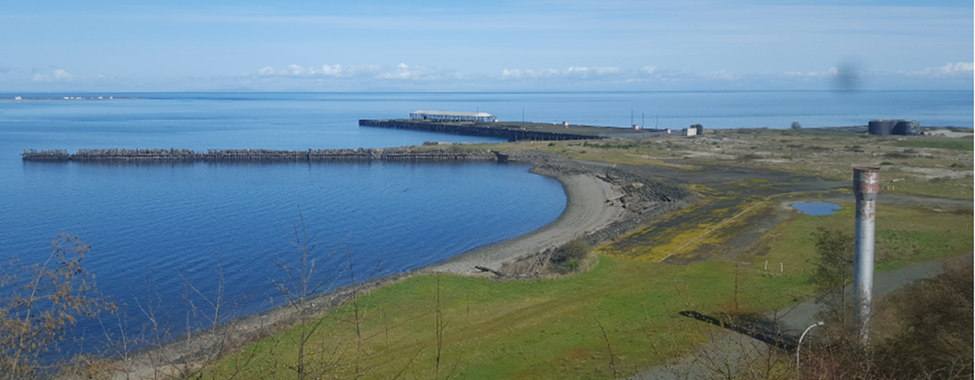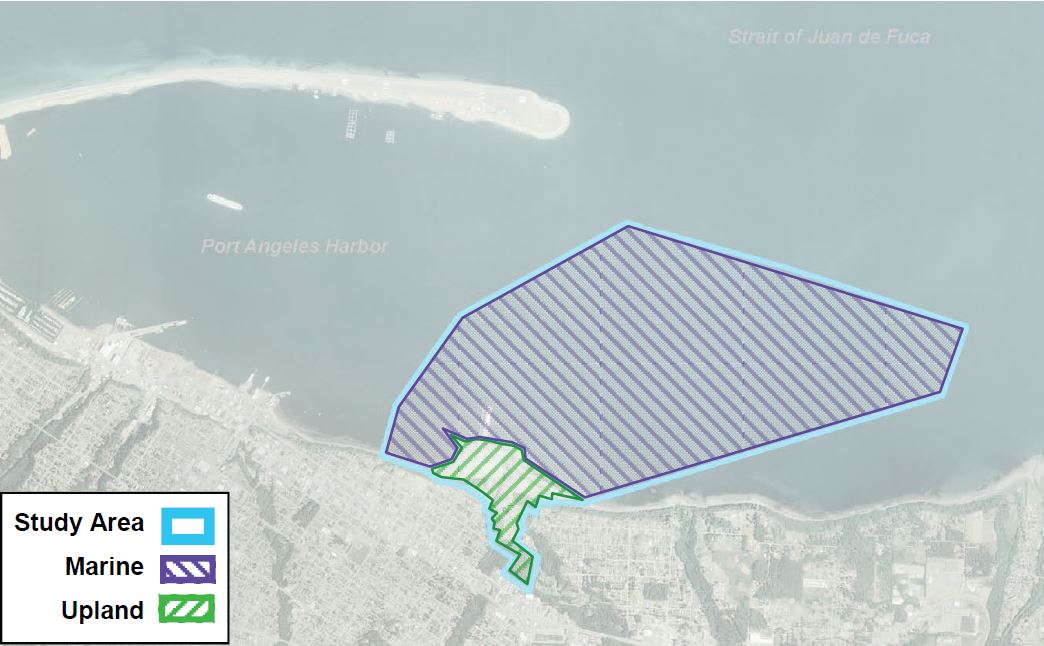
We invite you to comment on documents and attend an open house for the Rayonier Mill cleanup site on the shores of Port Angeles. The study area of this site is moving to the next phase of cleanup. Your feedback is an important part of this process.
Until the 1970s, the mill released untreated wastewater from the pulp-making process into Port Angeles Harbor. The mill also burned seawater-soaked wood in the hog fuel boilers. The smoke from the boilers carried pollutants, including dioxins. Other industrial chemicals were released into the environment as well. The mill started treating its wastewater in the 1970s. After this, it released less pollution into the harbor.
The Rayonier Mill Study Area
The Rayonier Mill cleanup is a large, complex project. Rayonier (formerly Rayonier, Inc, now Rayonier Advanced Materials and Rayonier A.M. Properties) and Ecology have studied the area and evaluated cleanup options for many years. We focused our investigations on a portion of the site, called the study area, where the highest levels of contamination are located.
Ecology is now proposing final cleanup actions for the study area, which has two main parts:
- Upland Area: Soil and groundwater on the former mill property
- Marine Area: Nearby harbor waters and contaminated sediments.


Proposed cleanup plans
Rayonier has already begun cleanup of the study area. Between 1993–2008, Rayonier removed over 30,000 tons of the most contaminated soil from the upland area. However, low levels of contamination still remain across the study area.
Some cleanups are done in phases, addressing the areas that need the most urgent attention first. When we clean up a section of a larger site like this, we call it an interim action. Interim actions can address parts of the larger site. The draft Interim Action Plan proposes how Rayonier will clean up the remaining contamination in the study area. This plan is designed to meet Washington’s cleanup standards and protect human health and the environment. We expect this Interim Action Plan will be the final cleanup actions needed for the Rayonier Mill study area.
Documents for your review and comment
Ecology worked with the Lower Elwha Klallam Tribe to develop and review these documents. We seek your input on the following:
- Legal Agreement: To move the cleanup forward, Ecology will enter into a consent decree with the parties responsible for cleanup—Rayonier A.M. Properties LLC and Rayonier Advanced Materials (collectively referred to as “RAMP” or “Rayonier”). The consent decree is a legal agreement that would require RAMP to carry out Ecology’s Interim Action Plan.
- Draft Interim Action Plan: Ecology’s proposed cleanup plan for the study area. It includes a schedule and cleanup requirements.
- State Environmental Policy Act (SEPA) Determination of Non-Significance: Ecology determined the proposed cleanup is not likely to cause significant environmental harm. We considered environmental, historical, and cultural factors in this process.
How to access and comment on the documents
Review documents online or in-person at the following locations:
- Port Angeles Main Library
- Ecology Lacey Office (by appointment only)
Submit comments from June 12–Aug. 12, 2025. Comment online or email or mail comments to Marian Abbett, site manager, WA Department of Ecology, PO Box 47775, Olympia, WA 98504-7775
Public meeting and open house
Join us for a public meeting and open house on Tues., 5–8 p.m., July 8, at Field Arts & Events Hall, Donna M. Morris Theater (201 W Front St, Port Angeles, WA 98362).
This is an opportunity to learn more about the cleanup, ask questions, and submit written comments.
The presentation starts at 6:00 p.m., followed by a question-and-answer session. We will host an open house before and after the presentation where you can talk to Ecology staff.
Estimated cleanup timeline and costs
The cleanup is expected to take up to 10 years including design, permitting, and construction. Soil cleanup should take 7 years, while groundwater and sediment cleanup may take 10 years. Since these efforts will happen at the same time, the full project is expected to be completed within 10 years. Adjustments may be made as the cleanup progresses.
The cleanup is expected to cost around $30 million. Rayonier is responsible for the costs of this cleanup and ongoing monitoring and maintenance.
What to expect next
- June 12 – Aug. 12, 2025: Public comment period on the consent decree, Interim Action Plan, and SEPA checklist and determination.
- Late summer–fall 2025: Ecology will review and respond to public comments. If updates to the documents are needed, they will be revised. The final documents will be submitted to the Superior Court for approval.
- After documents are finalized: Rayonier will follow the Interim Action Plan’s cleanup schedule.

